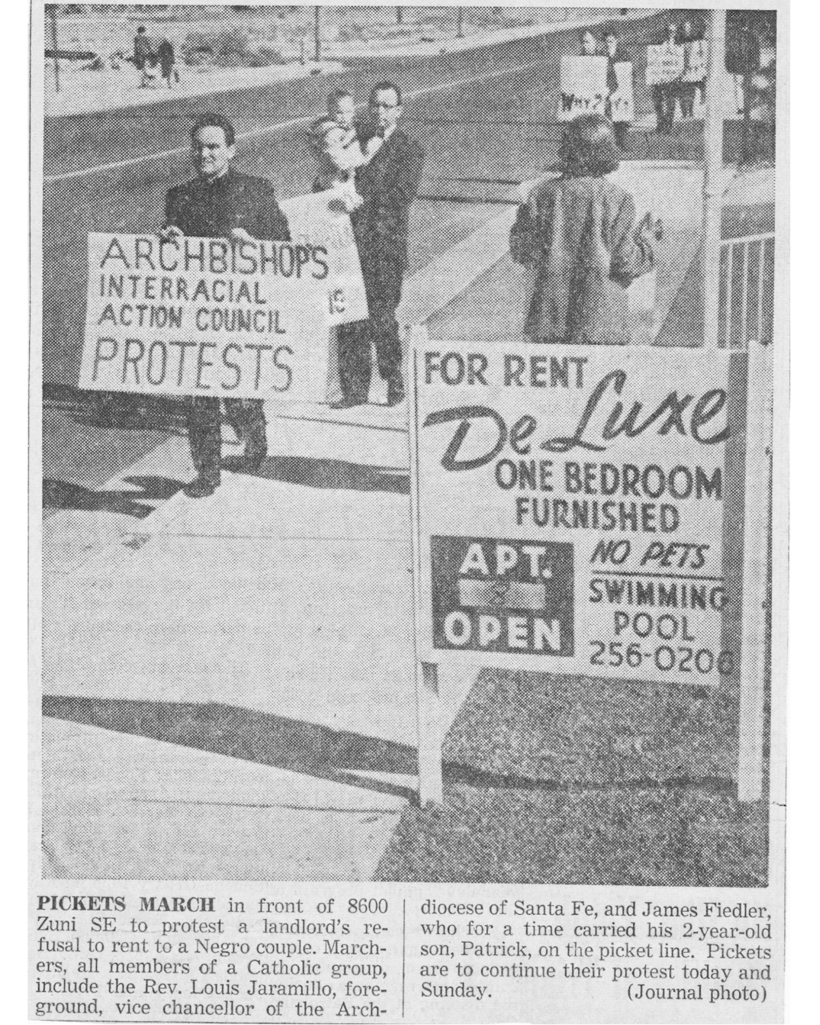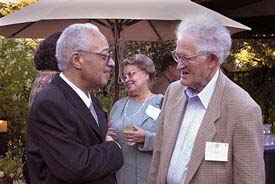Albuquerque Fair Housing Picket November 1964
In 1964, William J. Zimmer, PhD served on the Archbishop’s Interracial Action Council. He was also on the technical staff at Sandia National Laboratory. His friend, Arthur Walker Jr., was an Officer at Kirtland Air Force Base Weapons Laboratory and the First Vice President of the local NAACP. One morning Art called Bill at work and said that a new employee at Sandia Base, Steve Taylor, wanted to rent an apartment on Zuni Avenue. The manager of the apartment complex told Steve that no apartments were available since the apartment complex was filled to capacity. However, Taylor felt that the apartment manager did have available apartments, but that he did not want to rent to him because he was Black. Steve saw what appeared to be apartments that were empty of tenants. To determine if the apartment manager was lying and if the unavailability were true, Art asked Bill to go to the apartment complex and try to rent one. Bill, a White man, went to the apartment complex with a colleague from work, Richard Prairie, and asked about a rental at the complex. Bill was assured that, not only was one available, but that he could move in immediately.
With the cooperation of the NAACP and the UNM Newman Center, a picket in front of the apartment complex was begun on November 3. It ended on the 5th when the Albuquerque City Attorney began the first prosecution and trial of the apartment owner, James Markey, under Albuquerque’s new Fair Housing Law. Albuquerque’s Fair Housing Board recommended that the city attorney prosecute Markey, part owner and manager of the apartment complex at 8600 Zuni SE for violation of the city’s fair housing ordinance.
Among witnesses appearing for the complainant were William Zimmer, Richard Prairie and Arthur Walker Jr. After the defense attorney petitioned for a jury trial, Municipal Judge James Maloney in a precedent-setting move, ordered a special jury of 6 persons to hear the case. It was the first time an advisory jury has been summoned in a municipal court case in Albuquerque. Composed of 2 Negroes and 4 Whites, the jury deliberated for an hour and 52 minutes and voted 4 to 2 for conviction of the landlord. However, the judge declared a mistrial, but the intent of the city to prosecute such cases was noted by the city prosecutor. Prairie and Zimmer received hate phone calls, and burning garbage was thrown on the Zimmer family’s lawn the next night.
The City Attorney pointed out that a major element of the fair housing board’s function is conciliation. Nevertheless, the only Negro on the board, Mrs. Kenneth Lawson, felt that a landlord, by refusing to rent to minority citizens, makes himself liable for action under the ordinance. Such action could come in court, where a guilty finding could mean a $200 fine and 90 days in jail.
In Albuquerque, a strong point had been made about justice, interracial collaboration, and the power of friendship. Zimmer and Prairie remain friends over half a century later and feel proud that their children, grandchildren, and their community can know this history.

As I wrote this story about a significant event in my life, I thought that it probably was a significant event in the lives of the main protagonists who started the protest. Here is a bit about each of them.
Steve Taylor went on to a distinguished career in the United States Defense Industry. A brief view follows with acknowledgement at his retirement from the Honeywell Corporation ceremony: Kansas City Site Office Manager Steve Taylor retired on April 3, 2008, after 45 years of service to the government. Taylor had been manager of the Kansas City Site Office since March 17, 2004. Taylor joined the Atomic Energy Commission as a Technical Intern in 1964 and worked as a computer programmer and systems analyst. He served in a variety of highly responsible capacities in the Physical Scientist, Weapons Data Program Officer, Technical Information Manager, and Executive Officer positions at the Albuquerque Operations Office prior to his promotion as Deputy Manager Kansas City Area Office in 1986. He served as Deputy until his promotion as Site Manager in 2004.

Dr. Arthur B. C. Walker Jr. went on to an outstanding career in Physics.
Dr. Arthur Walker, who shot innovative telescopes into space to give scientists a view of the Sun that they had never seen before and who spent a lifetime helping women and minority students find careers in science, died at his home on the campus of Stanford University. He was 64 and a professor of physics and applied physics there.
After earning his Ph.D., Arthur Walker joined the Air Force Weapons Laboratory, 1962-65. There he was instrumental in developing instrumentation for an experiment that involved rocket launch of a satellite to measure Van Allen belt radiation in the Earth’s magnetic field which affects satellite operation. This work ignited his interest in research carried out with space techniques. From 1965 to 1973 he worked at Aerospace Corporation where, from 1971-73, he directed the Astronomy Program. He joined Stanford University as Professor, in 1974. From 1976-80, he was Associate Dean of Graduate Studies.
Arthur B. Walker started out in nuclear physics, but earned a Ph.D. in Astrophysics. From 1975 to 1985 Walker did pioneering work studying the X-ray spectrum of the solar corona and in the 1990s he lead a team of scientists who, among other things, were the first to apply normal incidence X-ray optical systems to astronomical observation. But Walker may be best known as the mentor of Sally Ride, the first female astronaut to orbit the Earth. He also chaired the presidential commission that investigated the 1986 space shuttle Challenger disaster.
Walker is one of nation’s bright lights in solar research. He has used his X-ray vision to see inside the sun’s surface. As a solar physicist, he is a leader in the use of thin films and X-rays to study its corona. Since 1987, telescopes Walker has developed have ridden satellites into space, capturing the first pictures of that corona. In addition, Walker’s penetrating long-range vision has resulted in Stanford having more minority graduate physics and applied physics students than any major research university in the country. Ever since his irate mother, Hilda, stormed into the highly academic Bronx High School of Science and set his teacher straight about discouraging her son from studying science because he is African-American, Walker has been steady on the course.
The Physics community celebrated his innovative research and inspiring teaching in Physics, particularly in Solar Physics, as well as his exemplary contributions to the Black community at Stanford. Art has transmitted his love of physics to generations of Stanford undergraduates through his introductory course on Observational and Laboratory Astronomy, and to dozens Ph.D. students in Physics and Engineering. And, further afield, Art’s scientific wisdom has often been placed in the service of this country. Dr. Walker served his nation in many ways as a Lieutenant in the Air Force to being a member of the presidential commission investigating the Challenger accident.
Art was also a dedicated father and husband. Art’s extended family will be comforted by the knowledge that his distinguished service has created a permanent legacy at Stanford University and within the discipline of Physics. On September 15, 2000, Stanford had a celebration of his achievements sponsored by the departments of Physics and Applied Physics and the African and Afro-American Studies Program.

Dr. Richard R. Prairie went on to become a Department Manager at Sandia Laboratory and, after he retired from Sandia, an Adjunct Professor at the University of New Mexico.
Dr. William J. Zimmer went on to become a Professor at the University of New Mexico in the Department of Mathematics and Statistics and a Professor Emeritus there.
Richard Prairie and William Zimmer have remained friends to this day, in 2017.

Subsequent articles in the Albuquerque Journal Newspaper were headlined:
Housing Board Urges Landlord Prosecution
Refused To Rent To A Negro
Fair Housing Case To Get Hearing By Special Jury
Fair Housing Case Ends In A Mistrial
THE POINT HAD BEEN MADE!!